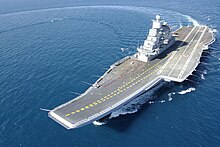Foreign relations and military
Modi and British Prime Minister Theresa May at the India-UK Tech Summit in New Delhi
Aside from ongoing strategic relations with Russia, India has wide-ranging defence relations with Israel and France. In recent years, it has played key roles in the South Asian Association for Regional Cooperation and the World Trade Organisation. The nation has provided 100,000 military and police personnel to serve in 35 UN peacekeeping operations across four continents. It participates in the East Asia Summit, the G8+5, and other multilateral forums.[197] India has close economic ties with South America,[198] Asia, and Africa; it pursues a "Look East" policy that seeks to strengthen partnerships with the ASEAN nations, Japan, and South Korea that revolve around many issues, but especially those involving economic investment and regional security.[199][200]
INS Vikramaditya, the Indian Navy's biggest warship.
Since the end of the Cold War, India has increased its economic, strategic, and military co-operation with the United States and the European Union.[206] In 2008, a civilian nuclear agreement was signed between India and the United States. Although India possessed nuclear weapons at the time and was not party to the Nuclear Non-Proliferation Treaty, it received waivers from the International Atomic Energy Agency and the Nuclear Suppliers Group, ending earlier restrictions on India's nuclear technology and commerce. As a consequence, India became the sixth de facto nuclear weapons state.[207] India subsequently signed co-operation agreements involving civilian nuclear energy with Russia,[208] France,[209] the United Kingdom,[210] and Canada.[211]
The President of India is the supreme commander of the nation's armed forces; with 1.395 million active troops, they compose the world's second-largest military. It comprises the Indian Army, the Indian Navy, the Indian Air Force, and the Indian Coast Guard.[212] The official Indian defence budget for 2011 was US$36.03 billion, or 1.83% of GDP.[213] For the fiscal year spanning 2012–2013, US$40.44 billion was budgeted.[214] According to a 2008 SIPRI report, India's annual military expenditure in terms of purchasing power stood at US$72.7 billion.[215] In 2011, the annual defence budget increased by 11.6%,[216] although this does not include funds that reach the military through other branches of government.[217] As of 2012, India is the world's largest arms importer; between 2007 and 2011, it accounted for 10% of funds spent on international arms purchases.[218] Much of the military expenditure was focused on defence against Pakistan and countering growing Chinese influence in the Indian Ocean



No comments:
Post a Comment